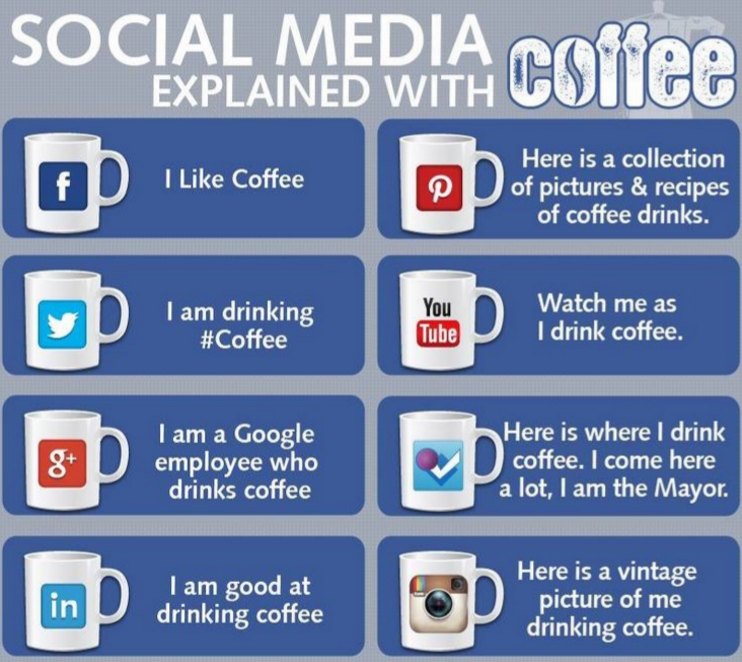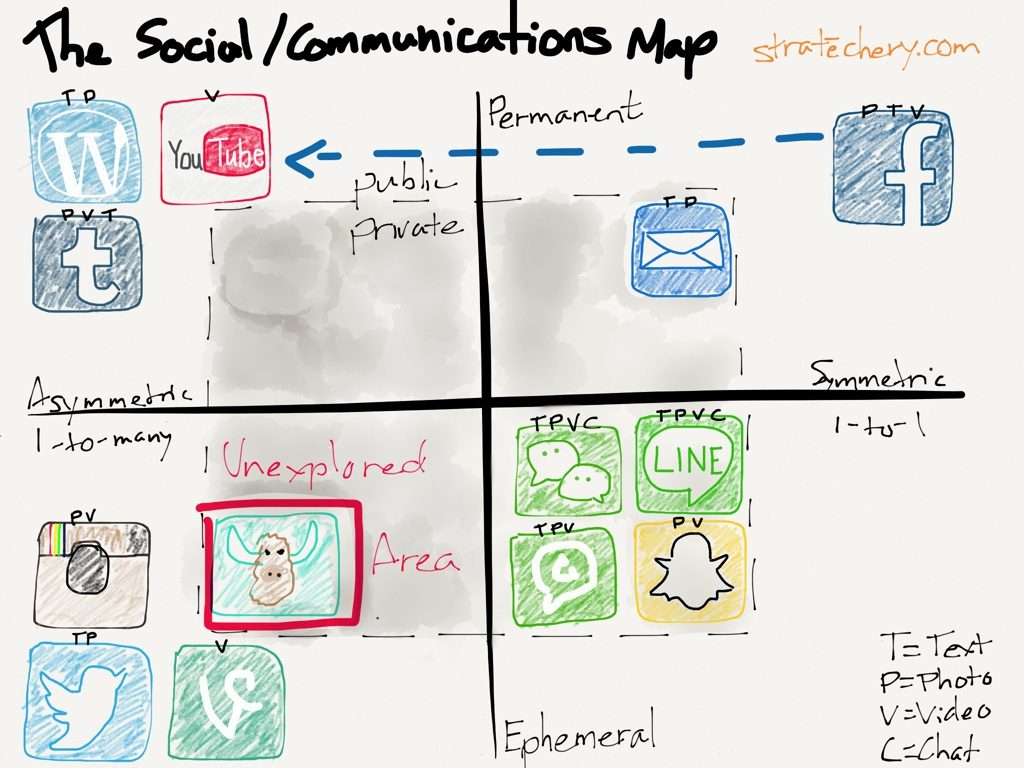
What to watch for
After completing this lesson, you’ll be able to:
- Outline the major issues related to social media and messaging
- Describe the current social media and messaging landscape
The first time I taught this class, these were two separate lessons. As I thought about it more, though, it made sense to combine them—messaging is huge
1, but it’s inextricably intertwined with the broader social media landscape.
Another kind-of new thing here: I’ll be sprinkling in, though not entirely relying upon, notes and ideas from the work of student groups in past semesters.
Finally, one last note: even though these are the most up-to-date sources I could find, they still feel a bit dated—that’s how fast this space in particular moves!
Required readings:
📚 “Social media
(17,450 words / 88-95 minutes)
- Spend some time starting at the graphic at the top of the article—such astounding variety. Really, though, it should be no surprise—social media and messaging are, in a sense, at the heart of nearly all new media and all computing. Tools that enable an individual to do something are amazing! But, outside of a very few odd cases, great individual efforts are ultimately shared with or performed for others. As a friend and mentor of mine once taught me, people first, then computers—or, to put it another way, computers for people—and relationships.
- “The variety of stand-alone and built-in social media services currently available introduces challenges of definition.” No joke.
- Time to feel like you’re getting your money’s worth out of this class. Here are some fancy college-y words for you: “Social media operate in a dialogic transmission system (many sources to many receivers). This is in contrast to traditional media that operates under a monologic transmission model (one source to many receivers).”
- I really like how this article wrestles with how exactly to define social media. Reminds me a lot of our first lesson, trying to define what new media is.
- I like the honeycomb framework “that defines social media by using seven functional building blocks: identity, conversations, sharing, presence, relationships, reputation, and groups.”
- The list of most popular social media platforms underscores a point that I hope to make more consistently throughout this course: people outside of the United States also use computers, and—shocker—they sometimes use them differently than we do. See some of the non-required readings for more on this.
- The notes on criticisms and negative effects in this article are worth reading thoroughly and considering thoughtfully. This highlights another issue I hope to make more consistently throughout the course: the downsides / negatives of the technologies we’re talking about. My individual personality is to look at the positives and the potential good unlocked by new technologies, but it’s vitally important to think critically about potential and actual negatives and downsides of new technologies.
- I thought it was mentioned in this article, but it isn’t, so I’ll include it here anyway. I think the term “context collapse” as defined here is very useful:
“Context collapse is a concept used by academics writing about the effects of social media and the contexts they give rise to. The term refers to the audiences possible online as opposed to limited groups we normally interact with in face-to-face interactions. In those bounded interactions, people adjust their tone and presentation to fit social context. In context collapse, this adjusting becomes impossible.” - The various “Impacts” sections are good reading, too.
📚 “Social Media Usage: 2005-2015” by Andrew Perrin
(1,605 words / 8-10 minutes)
A quick scan of the bolded statistics here will do. Still, very much worth reading / knowing!
📚 “Messaging: Mobile’s killer app” by Ben Thompson
(1,572 words / 8-10 minutes)
Ben Thompson is one of my favorite authors. Though I frequently disagree with him, his writing’s consistently thought-provoking and challenges me to look at the world from new perspectives.
In any case, the entire opening of the piece is worth quoting at length:
Before the Internet, the nodes of communication were houses, and the killer app was the telephone. Presuming both you and I were in our respective houses, I could dial a number, and we could talk. It was marvelous, and in retrospect, primitive; real-time is much less interesting, and much more limiting, when it’s the only means of communication.
In the late 1970s, the computer came along, and while it made us incredibly more efficient, it didn’t truly alter the definition of communication. That took the world wide web, and its killer app: the browser.
Now the nodes of communication were computers, and while real-time was still a possibility, it was passive communication that defined the web. I, along with every individual and organization on earth, could create a web page, and you could view it, at a time convenient to you. The place, though, was only at the computer.
Seven years ago, the computer became pocketable, but the original use cases were about making the passive presentation of information accessible not just at a time convenient to the viewer, but also at any place: the web was now everywhere.
Still, it’s only recently that the killer app for this era, when the nodes of communication are smartphones, has become apparent, and it is messaging. While the home telephone enabled real-time communication, and the web passive communication, messaging enables constant communication. Conversations are never ending, and friends come and go at a pace dictated not by physicality, but rather by attention. And, given that we are all humans and crave human interaction and affection, we are more than happy to give massive amounts of attention to messaging, to those who matter most to us, and who are always there in our pockets and purses.
Also worth noting is the Social / Communications map toward the end of the article:

Note especially the term “ephemeral.”
📚 Fall 2015 Student Notes on Social Media
Intro from John: The following are notes from the Fall 2015 section of NMIX 2010. I’ve included them because they provide concise, scannable information about the history of social media. Enjoy!
Earliest forms of social media:
1979 – UseNet
1988 – Internet relay chats
1997 – Six Degrees
By 2000, around 100 million people had access to the Internet
Late 1990s – AIM, blogs, chat rooms
2002 – Friendster
May 2003 – LinkedIn
July 2003 – Myspace
February 2004 – Facebook
July 2006 – Twitter
2007 – Tumblr
Since 2010
March 2010 – Pinterest
October 2010 – Instagram
June 2011 – Google+
September 2011 – Snapchat
June 2012 – Vine
📚 Fall 2015 Student Notes on Messaging
Intro from John: These notes are also from the Fall 2015 section of NMIX 2010 and provide some good quick background on the history of messaging.
Instant Messaging
Instant Messaging, also known as IM, became a more direct form of communication than previous messaging forms such as email. IM connects two people who are each online and lets them communicate in real time. Compare this to an email, which would be sent to a recipient who may be logged in or offline.
One of the earliest forms of IM was made possible by Mirabilis in November of 1996. It was called ICQ, which was short for “I seek you.”
Texting/Messaging Apps
The first text message was sent by Niel Papworth on December 3, 1992. Richard Jarvis was the recipient. It read “Merry Christmas”. Text messages are a form of asynchronous (not happening simultaneously) communication and are limited to 160 characters. This limit is based on research conducted by Friedhelm Hillebrand that argued that most messages could fit within that constraint.
In 1999, people were able to send text messages across networks. This is when texting began to gain traction.
In 2000, Americans were sending on average about 35 text messages a month.
In 2010, 6.1 trillion text messages were sent worldwide, which is about 200,000 per minute.
Non-required readings
“Teens, Social Media, and Technology Overview 2015” by Amanda Lenhart
A nice, relatively brief overview of the trends among what many would consider the most important (or at least most trend-setting) demographic for social media and messaging.
“Snapchat’s ladder” by Ben Thompson
Another great read from Ben Thompson, this time focusing on Snapchat.
Discussion Questions
- Describe your typical day of social media / messaging use.
- What was the first social media tool / messaging tool you used?
- What are your thoughts about ephemeral messaging?
- Discuss the concept of “context collapse.”
Words on / reading time for this page: 1,712 words / 8-11 minutes
Words in / reading time for required readings: 23,698 words / 119-133 minutes
Total words in / reading time for this lesson: 22,952 words / 127-144 minutes
It’s so hot right now.↩